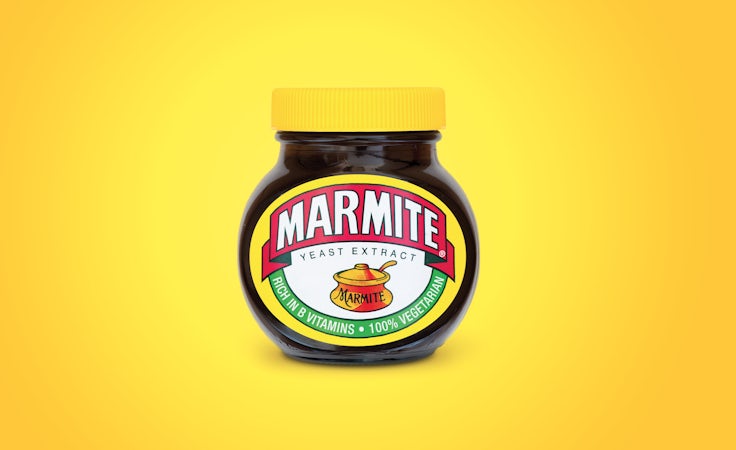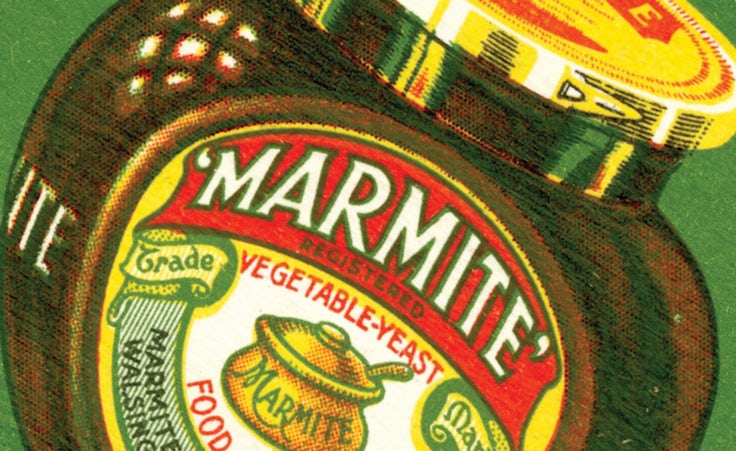Marmite – the marketing story even the haters love
Marmite is the £37m brand that took home this year’s Brand of the Year at the Marketing Week Engage Awards. Why?


Whether you love it or hate it, Marmite’s marketing can’t be ignored. Following its controversial ‘End Marmite Neglect’ campaign last year, the Unilever-owned brand saw a 14% increase in sales, huge growth in its social media following and a wave of press attention. The campaign, which parodied animal rescue programmes by focusing on ‘neglected’ jars at the back of people’s cupboards, also helped Marmite to bag the 2014 Brand of the Year title at Marketing Week’s Engage Awards.
Judges chose Marmite from a shortlist of brands that performed consistently well on YouGov’s BrandIndex measure, those that prompted online conversations (‘Buzz’) and those that showed most improvement through the eligibility period. According to YouGov’s UK CEO Tim Britton, Marmite’s Buzz score following the launch of End Marmite Neglect on 5 August 2013 shows the campaigng had a clear and sustained impact on consumers (see graphs).
“Its Ad Awareness scores, which show just how much attention the adverts got, increased from around 3% of people being aware of Marmite ads in early August to 23% at the end of that month. The ads also created chatter around the brand, with the word of mouth exposure score increasing notably, from 9% of the population discussing the brand with family and friends at the start of August 2013 and 14% doing so at the month’s end.”

Fresh from Marmite’s win, Marketing Week visited its factory in Burton-on-Trent – located amongst breweries like Molson Coors that provide the yeast the spread is made from – to meet the people behind the brand. As well as the marketers, they include veteran quality specialist St John Skelton, who lives and breathes all things Marmite. He is philosophical about why the brand’s equity resides primarily in its 112-year heritage and ‘Love it or hate it’ strapline.
“Marmite is a very aggressive flavour,” he says. “It’s a great smack in the teeth, and the thing is that some people don’t like a great smack in the teeth, and some of us do.” Revelling in the details of how the sticky brown paste is made, Skelton is full of interesting and bizarre facts, noting that Burton’s gleaming vats produce enough Marmite “to cover Vatican City” every seven weeks. The plant churns out 250 jars of Marmite every minute or 17 million a year.
Punching above its weight
Despite its prominence, Marmite is a relatively small brand in financial terms. It generated £37m in sales last year, according to Nielsen data, and although it serves a few expatriate communities, it is primarily a UK-only brand. It also advertises on TV relatively rarely, 2011 and 2013 being the most recent examples.
Jon Goldstone, vice-president of brand building for food and refreshment at Unilever UK and Ireland – the portfolio in which Marmite sits – admits that the impressive results of the End Marmite Neglect campaign have prompted him to put more marketing investment behind the brand for 2015, with a return to TV a possibility. While the size of Marmite’s budget is in keeping with its small revenue relative to other Unilever brands like Pot Noodle, Magnum ice cream and Hellmann’s mayonnaise, he notes that it also yields one of the clearest returns on investment when backed with a big spend.
“Marmite is a very aggressive flavour. It’s a great smack in the teeth, and the thing is that some people don’t like a great smack in the teeth, and some of us do.”
St John Skelton, Marmite
“Marmite is one of the few brands in our portfolio that we barely promote – it is almost always sold at full price,” he says. “With many brands you invest money in a new campaign but you’re never too sure whether it’s the advertising that drove a sales uplift or whether it was the gondola end in the supermarket. With Marmite, we see very pure increases in base sales rates as a result of campaigns like ‘Neglect’.”
Goldstone says the percentage of “toast occasions” that Marmite features in is still “tiny” and believes the opportunity to increase consumption among the breakfast-eating public is significant. He expresses satisfaction that the £2m End Marmite Neglect campaign succeeded in drawing new people to the brand while simultaneously reminding “lapsed users” of their former love for the product.
“We didn’t want to throw the baby out with the bathwater and create a completely new advertising idea, but we needed to do something that just jolted people a bit and made the whole proposition a little more relevant,” he says. “The ambition from the start was to create something that would be right up there with the best advertising we’ve ever done on Marmite – for it to feel fresh but also respectful of the past and the very set memory structures that people have around the Marmite brand.”
End Marmite Neglect, which broke in August 2013, was born out of customer insight that showed a high proportion of Marmite lovers were forgetting about the product and that as a result, their jars had been pushed to the back of the kitchen cupboard. This trend, combined with rising competition from sweeter-tasting products such as chocolate spreads and honey, meant Marmite sales dipped 5% in value last year, according to Nielsen.
The parody TV advert, which showed a team of rescuers saving forgotten Marmite jars from people’s homes, built on the brand’s longstanding slogan by using the line ‘Love it or hate it, just don’t forget it’. It was given gravitas by the voice of former BBC newsreader Michael Buerk, who narrated emergency services documentary series 999 Lifesavers in the Nineties.
The brand also ran an extensive social media and experiential campaign, in which people could nominate their friends to provide a good home for a ‘neglected’ jar, delivered by the Marmite ‘re-homing unit’. Value sales rose by 14% during the eight weeks that the campaign was live compared with the previous eight weeks, while the campaign helped to attract 12,000 new social media followers in three months and generated 157 pieces of press coverage at an estimated PR value of £2.4m.
Provoking debate
This level of coverage was undoubtedly helped by the provocative nature of the campaign, which prompted over 500 complaints to the Advertising Standards Authority (ASA) from viewers who claimed the advert was distasteful and made light of the work of animal charities. Unilever responded to the furore by donating £18,000 to the RSPCA, though the ASA decided not to launch an investigation on the grounds that the ad was recognisable as a spoof. At the height of the controversy, the campaign appeared on the front page of The Daily Telegraph and in a 10-minute discussion on ITV’s The Wright Stuff.
“You have to take a risk for advertising to be effective,” says Marmite brand manager Joanne O’Riada, though she claims the brand never intended to cause offence. “Marmite’s ‘Love it or hate it’ strapline is born out of the fact that it polarises reactions and everyone has an opinion about it. We wanted to reassert that identity in a way that was fun and humorous.”
“It’s testament to the brand that there are many people who don’t like the product but who love engaging with the brand.”
Joanne O’Riada, Marmite
Following the plaudits of 2013, this year has been a much quieter one for Marmite. The brand has focused on developing its social media presence, which includes over 1 million fans of its ‘love’ page on Facebook as well as 200,000 fans of its ‘hate’ page. Led by O’Riada with support from social agency Splendid, Unilever’s Marmite team has significantly upped its investment in social media in the last couple of years in a bid to engage fans online with inventive and quirky content.
“Our marketing strategy is essentially about reminder communications and keeping the brand top of consumers’ consideration set,” explains O’Riada. “There are very active fans on social media who will share a lot of Marmite content, but it’s testament to the brand that there are also many people who don’t like the product but who love engaging with the brand.”
Evolving a family favourite
This picture of the brand is vastly different from when it was founded in 1902 as the Marmite Food Company, even though the product has barely changed. It traded on a wholesome, healthy image for most of the 20th century. The spread’s various nutritional attributes, including five B vitamins, saw it included in soldiers’ ration packs during the First World War and in the 1950s it even had its own medical sales team selling to the National Health Service.
Marketing for the brand in the 1970s and 80s reflected its healthy positioning with straplines like ‘The growing up spread’ and ‘My mate, Marmite’, reinforcing its status as a breakfast cornerstone and reliable family staple. But by the mid-1990s, Marmite was under pressure from a growing number of competitor spreads and demographic and cultural changes that were chipping away at the prevalence of traditional breakfast occasions.
Tasked with giving the brand a new lease of life, in 1996 a creative team within ad agency BMP DDB (now Adam&eveDDB, which still holds the account) hit upon the idea of using Marmite’s ability to polarise opinion as its key selling point. The ‘Love it or hate it’ proposition was born and has remained central to the brand since Unilever acquired it in 2000.
“It’s a brand that’s much bigger in people’s minds than perhaps it is in reality,” suggests James Murphy, chief executive of Adam&eveDDB. “Anyone working on this brand knows they’re taking on much more than just a legacy of good advertising – they’re taking on a national treasure.”
He believes that Marmite’s ironic and quirky identity has particular resonance with British consumers and questions whether the brand would have the same traction in other markets like the US. Marmite regularly plays on its iconic status within British culture, such as by launching a limited-edition ‘Ma’amite’ jar for the Queen’s Diamond Jubilee in 2012.
“British consumers like brands that are authentic and which communicate with them in an intelligent way,” says Murphy. “They enjoy jokes that reward their intelligence, rather than being bludgeoned by a particular message.”
Marmite’s cultural permeation is best demonstrated by the fact that the brand name has entered the British vernacular as a shorthand for anything or anyone that polarises opinion. The brand name regularly appears in the media for this purpose and is often the inspiration for clever and quirky expressions by those who appropriate it. Following the death of Margaret Thatcher last year, for example, the Guardian newspaper ran an advert to promote its coverage of the event that featured a jar of Marmite with the name ‘Margaret’ as the brand.
Unilever has also built a huge licensing business off the back of Brits’ affection for the brand, allowing it to sell Marmite-branded products to haters, as well as lovers. Marmite was the first brand Unilever licensed out 10 years ago and this now accounts for around £15m of additional sales each year. Products range from Marmite-flavoured chocolate and rice cakes to branded teapots, board games and aprons. Julie McCleave, head of licensing at Unilever, says her department often takes inspiration from Marmite’s highly active fanbase on social media for ideas on how to apply the Marmite brand to new products and concepts (see Q&A, below).
The most obsessive super fans have gone to particularly extreme lengths to prove their love, with one painting the front of her house to look like a giant Marmite jar last year and another changing his surname by deed poll to Marmite.
At the heart of this culture is quality specialist Skelton, who began working at the Burton plant in 1974 and who has become something of a celebrity to Marmite aficionados. To celebrate the brand passing one million fans on Facebook last year, he appeared in an online video sitting in a bath of Marmite.
But even he says he is taken aback by the level of passion displayed by certain Marmite lovers. “Some of them,” he says, “are unrestrainable.”

Q: How do you decide which products to license the Marmite brand to?
On the one hand we have food products like Marmite-flavoured crisps, breadsticks, rice cakes and even cheese and chocolate. If you look at the communication that happens on Facebook you can see that people enjoy experimenting with the product and sharing their ideas and concepts.
We try to reflect that with the licensing range. When we launched Marmite chocolate a couple of years ago we initially produced 100,000 units and thought we would do well to sell that, but the stock was sold in a matter of weeks and we had to go into extra production to fulfil the demand.
Q: Which non-food Marmite branded products are popular?
One of the original products we launched under licensing was a cycling top. You often still see cyclists wearing them with the strapline ‘love Marmite, hate jams’. We’ve got a huge archive of old advertising images, products and designs and our gifting range harks back to some of that old imagery – our teapot and mug is part of a Christmas gifting range, for example. There’s a big trend among consumers at the moment around heritage and retro.
Q: What principles are important when licensing a brand?
Licensing isn’t just a badging exercise, it’s about making sure that the brand reflects retail trends that are already out there. Even within Unilever, people don’t necessarily appreciate that some of the products we work on are actually licensed products and not products that we manufacture and sell directly ourselves. That’s the way it should be because as far as consumers are concerned, it’s a direct representation of the brand.






